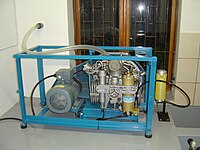
Photo from wikipedia
Although radial access is the current gold standard for the implementation of percutaneous coronary interventions (PCI), post-procedural radial compression devices are seldom compared with each other in terms of safety… Click to show full abstract
Although radial access is the current gold standard for the implementation of percutaneous coronary interventions (PCI), post-procedural radial compression devices are seldom compared with each other in terms of safety or efficacy. Our group aimed to compare a cost effective and potentially green method to dedicated radial compression devices, with respect to access site complications combined in a device oriented complex endpoint (DOCE), freedom from which served as our primary endpoint. Patients undergoing PCI were randomized to receive either the cost effective or a dedicated device, either of which were removed using patent hemostasis. Twenty-four hours after the procedure, radial artery ultrasonography was performed to evaluate the access site. The primary endpoint was assessed using a non-inferiority framework with a non-inferiority margin of five percentage points, which was considered as the least clinically meaningful difference. The cost-effective technique and the dedicated devices were associated with a comparably low rate of complications (freedom from DOCE: 83.3% vs. 70.8%, absolute risk difference: 12.5%, one-sided 95% confidence interval (CI): 1.11%). Composition of the DOCE (i.e., no complication, hematoma, pseudoaneurysm, and radial artery occlusion) and compression time were also assessed in superiority tests as secondary endpoints. Both the cost-effective technique and the dedicated devices were associated with comparably low rates of complications: p = 0.1289. All radial compression devices performed similarly when considering the time to complete removal of the respective device (120.0 (inter-quartile range: 100.0–142.5) for the vial vs. 120.0 (inter-quartile range: 110.0–180) for the dedicated device arm, with a median difference of [95% CI]: 7.0 [−23.11 to 2.00] min, p = 0.2816). In conclusion, our cost-effective method was found to be non-inferior to the dedicated devices with respect to safety, therefore it is a safe alternative to dedicated radial compression devices, as well as seeming to be similarly effective.
Journal Title: Diagnostics
Year Published: 2023
Link to full text (if available)
Share on Social Media: Sign Up to like & get
recommendations!